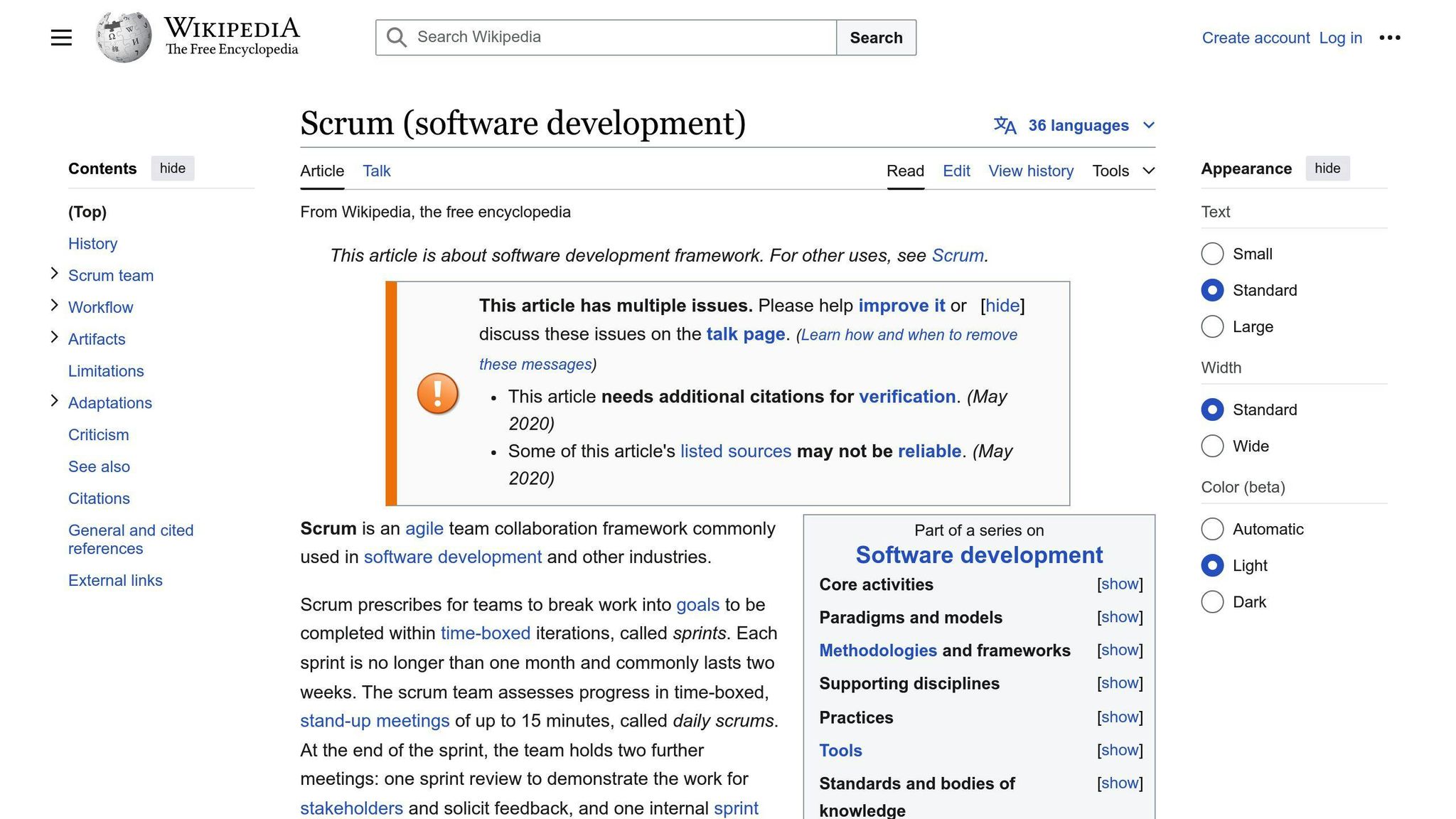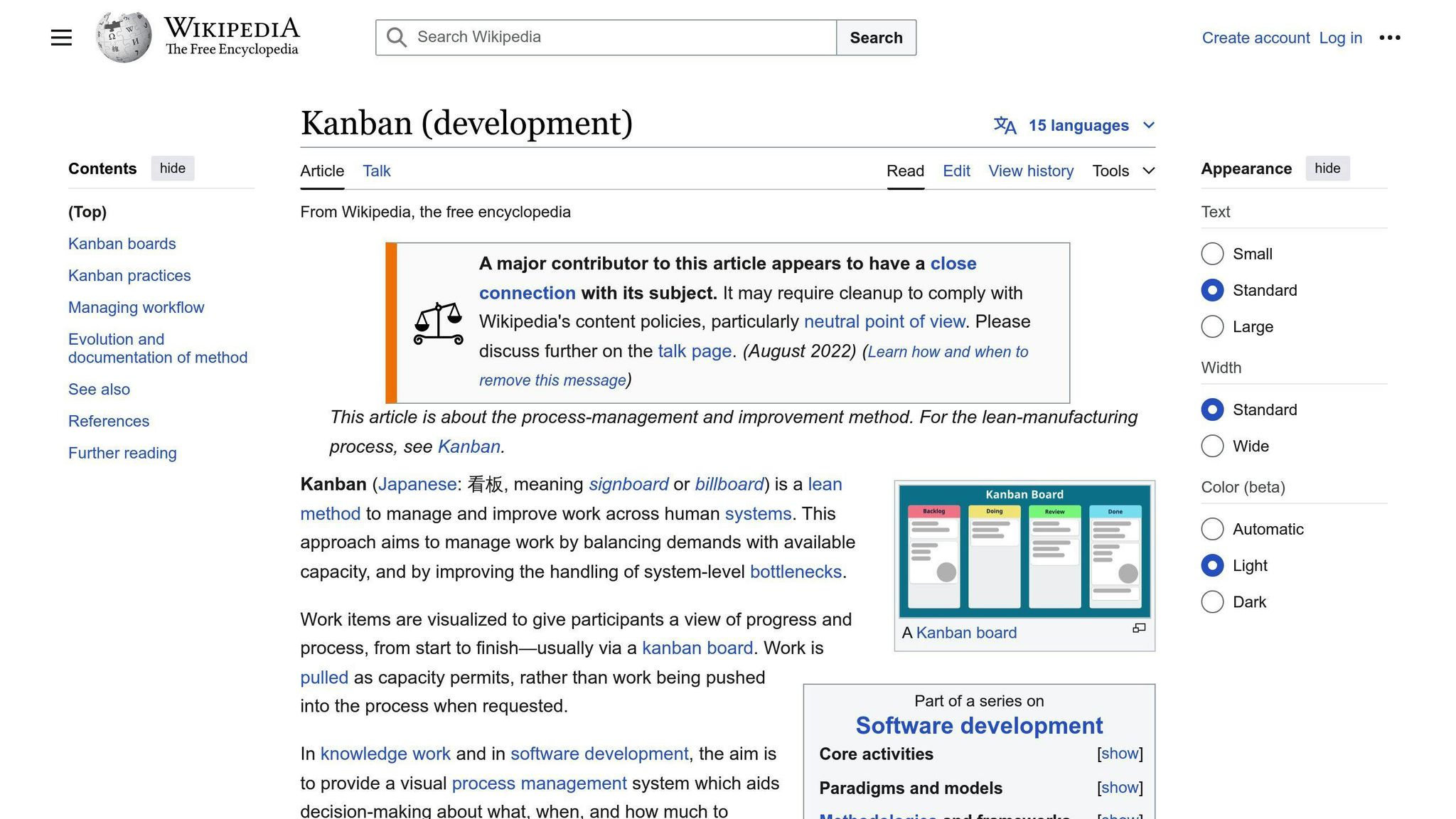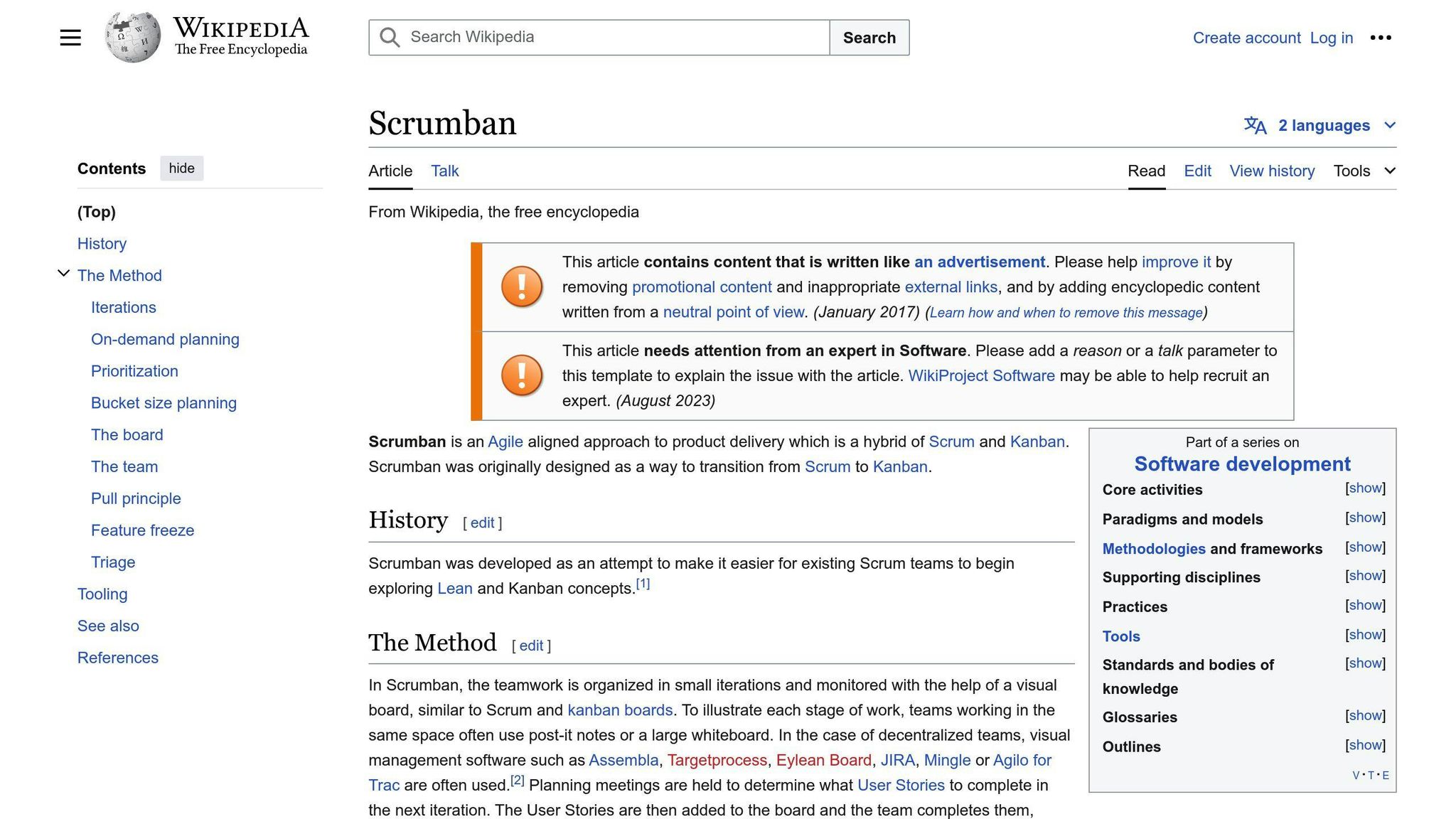


Comparing Scrum and Kanban agile frameworks for remote teams. Learn about the key differences, benefits, and challenges of each methodology. Explore Scrumban as a hybrid approach.
Scrum and Kanban are two popular agile methodologies for managing projects and workflows, each with its own strengths and approach. Here's a quick comparison:
Related video from YouTube
Scrum

- Structured framework with defined roles, ceremonies, and sprints
- Suitable for complex projects with fixed deadlines and deliverables
- Focuses on collaboration, continuous improvement, and customer satisfaction
- Better suited for teams that require a high level of structure and discipline
Kanban

- Flexible, visual workflow management approach
- Ideal for projects with changing priorities and requirements
- Emphasizes continuous improvement and delivery
- More adaptable to teams with varying levels of experience and expertise
| Criterion | Scrum | Kanban |
|---|---|---|
| Workflow Management | Fixed sprints | Continuous flow |
| Team Roles | Defined roles | Flexible roles |
| Meetings | Daily stand-ups, Sprint Planning, Reviews, Retrospectives | Fewer scheduled meetings |
| Performance Tracking | Sprint velocity, goals, burn-down charts | Lead time, cycle time, WIP limits |
| Flexibility | Less flexible during sprints | Continuous adjustments |
The choice between Scrum and Kanban depends on the unique needs and goals of your project and team. By understanding the strengths and weaknesses of each framework, you can make an informed decision and adopt the approach that best suits your project management needs.
For small teams, Kanban's flexibility and simplicity may be a better fit, while Scrum's structured approach can be more challenging to implement and maintain. Agile methodologies can work effectively in remote settings, with practices like daily standups, frequent retrospectives, and a focus on collaboration and adaptability helping to mitigate communication barriers.
What is Scrum?
Scrum is a popular framework for managing projects in an Agile way. It focuses on teamwork and making steady progress toward specific goals.
The Basics
Scrum works like this:
- Iterative Development: Break down big projects into smaller chunks. Deliver a working product at the end of each iteration.
- Continuous Improvement: Regularly review the product and process. Identify ways to get better.
- Data-Driven Decisions: Use real data and observations to make informed choices. Adapt as needed.
Team Roles
A Scrum team has three roles:
| Role | Responsibility |
|---|---|
| Product Owner | Define and prioritize the product backlog. Keep it up-to-date. |
| Scrum Master | Facilitate Scrum meetings. Ensure the team follows Scrum practices. Remove obstacles. |
| Development Team | Cross-functional team members who work together to deliver a working product increment. |
Meetings
Scrum has four key meetings:
| Meeting | Purpose |
|---|---|
| Sprint Planning | Set goals and plan work for the upcoming sprint. |
| Daily Stand-up | Team members share progress, plans, and obstacles. Stay on track. |
| Sprint Review | Demonstrate the working product increment. Get feedback from stakeholders. |
| Sprint Retrospective | Reflect on the sprint. Identify improvements for the next sprint. |
Artifacts
Scrum uses three artifacts:
- Product Backlog: A prioritized list of features or user stories.
- Sprint Backlog: Tasks to be completed during the current sprint.
- Increment: The sum of all completed product backlog items in a sprint.
Pros and Cons
Scrum offers benefits like:
- Improved team collaboration and communication
- Faster time-to-market through iterative development
- Flexibility to respond to changing requirements
However, it also has some drawbacks:
- Requires significant changes in team and organizational culture
- Can be challenging for large or distributed teams
- May not suit projects with fixed deadlines or rigid requirements
What is Kanban?
Kanban is a visual way to manage work. It helps teams work smoothly and get things done, especially for remote teams.
The Basics
Kanban focuses on:
- Visualizing Work: Show the workflow and tasks on a board. This makes it easy to see progress and spot any issues.
- Limiting Work in Progress: Set limits on how many tasks can be worked on at once. This prevents overload and keeps work moving.
- Managing Flow: Constantly check and improve the workflow to ensure tasks move through the system efficiently.
Kanban Boards
A Kanban board shows the workflow in columns. Each column represents a stage of the process. Tasks or user stories move across the columns as work progresses.
Common columns include:
| Column | Purpose |
|---|---|
| Backlog | List of tasks to be done |
| Ready | Tasks ready to start |
| In Progress | Tasks currently being worked on |
| Done | Completed tasks |
Teams can customize the columns to fit their needs.
Key Metrics
Kanban teams track these metrics:
| Metric | Description |
|---|---|
| Lead Time | Time for a task to go from backlog to done |
| Cycle Time | Time for a task to move through the whole workflow |
| Throughput | Number of tasks completed in a given time |
| WIP Limits | Maximum tasks allowed in each column |
Pros and Cons
Pros:
- Flexible: Kanban can adapt to different workflows and teams.
- Visual: The board clearly shows the workflow and progress.
- Continuous Improvement: Teams can constantly improve the workflow.
Cons:
- Lack of Structure: Flexibility can lead to a lack of structure for some teams.
- Focus on Speed: Too much focus on throughput can cause burnout.
sbb-itb-bfaad5b
Comparing Scrum and Kanban
Workflow Management
Scrum uses fixed time periods called "sprints" to complete tasks. Kanban has a continuous workflow where tasks move through stages without set deadlines.
Team Roles
Scrum has defined roles like Product Owner, Scrum Master, and Development Team. Kanban does not assign specific roles, allowing flexibility.
Meetings
Scrum requires daily stand-ups, Sprint Planning, Reviews, and Retrospectives. Kanban has fewer scheduled meetings, relying on ongoing team communication.
Performance Tracking
Scrum tracks sprint velocity, goals, and burn-down charts. Kanban focuses on lead time, cycle time, and work-in-progress (WIP) limits.
Flexibility
Scrum is less flexible during sprints. Kanban allows continuous adjustments to the workflow.
| Criterion | Scrum | Kanban |
|---|---|---|
| Workflow Management | Fixed sprints | Continuous flow |
| Team Roles | Defined roles | Flexible roles |
| Meetings | Daily stand-ups, Sprint Planning, Reviews, Retrospectives | Fewer scheduled meetings |
| Performance Tracking | Sprint velocity, goals, burn-down charts | Lead time, cycle time, WIP limits |
| Flexibility | Less flexible during sprints | Continuous adjustments |
This table highlights the key differences between Scrum and Kanban, helping remote teams choose the right approach for their needs.
Combining Scrum and Kanban: Scrumban

What is Scrumban?
Scrumban is a project management approach that blends elements of Scrum and Kanban. It combines the structure of Scrum with the visual workflow management of Kanban boards.
When to Use Scrumban
Scrumban is useful for teams that want a flexible yet structured approach. It's a good fit if your team:
- Needs more flexibility than traditional Scrum
- Wants to visualize and prioritize tasks
- Needs to adjust processes regularly
- Wants to combine the benefits of Scrum and Kanban
Scrumban can also help teams transitioning between Scrum and Kanban. It allows them to experiment and find the right balance.
Potential Challenges
While Scrumban offers advantages, it also presents some challenges:
- Finding the right balance: Teams need enough structure for guidance, but also flexibility.
- Understanding the approach: Team members may need training to work effectively with Scrumban.
| Potential Challenge | Description |
|---|---|
| Finding the right balance | Teams need enough structure for guidance, but also flexibility. |
| Understanding the approach | Team members may need training to work effectively with Scrumban. |
Overall, Scrumban provides a customizable approach that combines the benefits of Scrum and Kanban. Teams can tailor it to their specific needs.
Conclusion
Key Points
In summary, Scrum and Kanban are two popular Agile frameworks that cater to different project management needs. Scrum is ideal for projects with complex, multifaceted goals, while Kanban is better suited for projects with many teams and players. Both frameworks have their strengths and weaknesses, and the choice between them depends on the specific needs and context of the project and team.
When deciding between Scrum and Kanban, consider the following key points:
| Criterion | Scrum | Kanban |
|---|---|---|
| Structure | Structured framework with defined roles, ceremonies, and sprints. Suitable for projects with fixed deadlines and deliverables. | Flexible, visual workflow management approach. Ideal for projects with changing priorities and requirements. |
| Team Dynamics | Better suited for teams that require a high level of structure and discipline. | More adaptable to teams with varying levels of experience and expertise. |
| Approach | Prescriptive approach with a focus on collaboration, continuous improvement, and customer satisfaction. | Flexible and adaptable approach with a focus on continuous improvement and delivery. |
Ultimately, the choice between Scrum and Kanban depends on the unique needs and goals of your project and team. By understanding the strengths and weaknesses of each framework, you can make an informed decision and adopt the approach that best suits your project management needs.
FAQs
Is Kanban or Scrum better for small teams?
| Framework | Suitability for Small Teams |
|---|---|
| Kanban | Kanban may be a better choice for small teams due to its flexibility and simplicity. It allows teams to visualize their workflow, limit work-in-progress (WIP), and quickly adapt to changing priorities without much overhead. |
| Scrum | Scrum's structured approach with defined roles and ceremonies can be more challenging for small teams to implement and maintain. |
Can agile work remotely?
Yes, agile methodologies can work effectively in remote settings. While remote teams face challenges like lack of face-to-face interaction and potential communication barriers, agile practices help mitigate these issues:
- Daily standups keep teams aligned
- Frequent retrospectives promote continuous improvement
- Focus on collaboration and adaptability
Which agile framework should I use?
The choice of agile framework depends on your project's needs and team dynamics:
| Scenario | Recommended Framework |
|---|---|
| Complex projects with well-defined requirements | Scrum's structured approach may be suitable |
| Teams with constantly changing priorities or new to agile | Kanban's flexibility can be a good fit |
| Evaluating factors like team experience, project complexity, and the need for structure versus adaptability can help you choose the right framework. |

.png)








